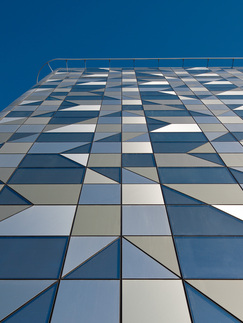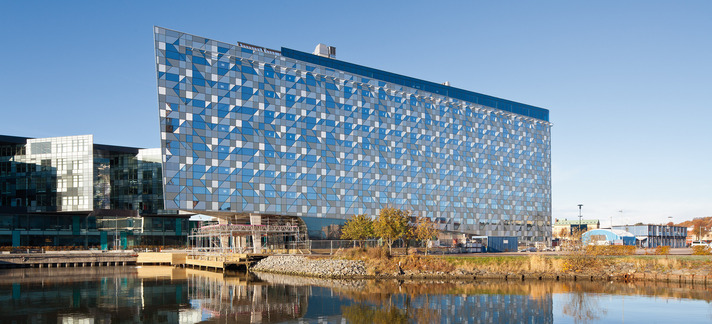-


Radisson Blu Hotel
Completed in March 2013, the Radisson Blue Riverside hotel in the Swedish port city of Gothenburg overhangs the Göta river like a shimmering shard of titanic proportions.
Constructed for Radisson Hotel’s owner the Winn Hotel Group by major Swedish contractor Skanska, this striking building accommodates 266 guest rooms, together with conference facilities, a bar and restaurant with outdoor seating, and a deluxe roof-top spa.
Images courtesy of Arconic Architectural Products
Architect Reflex Arkitekter AB (Moritz Kirchmeier / Marco Folke Testa) Location Göteborg - Sweden Company involved Arconic Architectural Products Website http://www.arconic.com
The hotel covers 12 floors, two of which are underground, with a total are of approximately 12,000 square metres. Its impressive volume, in part appearing to hover over the water, constitutes a new landmark in the Lindholmen district of the port city, once a centre for shipbuilding, and now the site of a new technology and science park.
The building is perceived as a sculpture of abstract scale clad in glimmering scales, explains architect Marco Falke Testa, from Stockholm-based practice Reflex Arkitekter. It is oriented towards the centre of Gothenburg, he explains, and after dark, the glazed end façade which looks out across the estuary becomes a glowing beacon when viewed from the city.
The façade is inspired by fish skin, more specifically that of a mackerel, Testa adds. “We wanted to work with [the idea of] sea glittering, and to emphasise reflections.” The back part of the building is rounded, he says, “in order to achieve a continuous façade which suits it like a dress.”
Thanks to a clever combination of glass and two types of brushed aluminium panels the interplay of light and reflected water on the building’s longer side elevations means that its colour is changing constantly, in response to the weather and amount of daylight.
Alcoa Architectural Products supplied more than 3,500 square metres of Reynobond® Brushed Natural Aluminium and Reynobond® Brushed Stainless Steel aluminium cladding to this project, the latter featuring a highly reflective, transparent coating. The two different types of brushed aluminum panels, installed by contractor Staticus UAB, are orientated in four different planes. They are combined with highly reflective rectangular and triangular glass panels - some covering windows, other not.
“The idea of mixing reflective glass panels together with aluminum ones makes it more difficult for those looking at the building to understand the position of the window, which in turn helps achieve a more sculptural effect,” says Testa. “Our intention was to make difficult for the human eye to understand the number of floors within the building”.
The Radisson Blu Riverside hotel was planned with sustainability in mind, explains Testa, and the building achieves internationally-recognised LEED (Leadership in Energy and Environmental Design) Gold certification. It is, he adds, extremely energy efficient, economical in its water consumption levels and features a living roof. The use Alcoa Architectural Products’ aluminium cladding, which he describes as “absolutely not expensive” contributes to the building’s LEED credentials.
The interior, designed by Doos Architects, a design practice also located in Stockholm, boasts an “urban eclectic” theme inspired both by Gothenburg’s shipbuilding heritage and the hotels proximity to the the city’s burgeoning science and technology hub. Interior materials include wood, iron and copper. “Contrasts and worked-through details such as matt-glossy, dark-light and warm-cold colours enhance the sought after feeling of warmth and care” says Doos. The result, it claims, is a hotel with more individual expression than that of the usual business hotel.
Images courtesy of Alcoa Architectural Products













